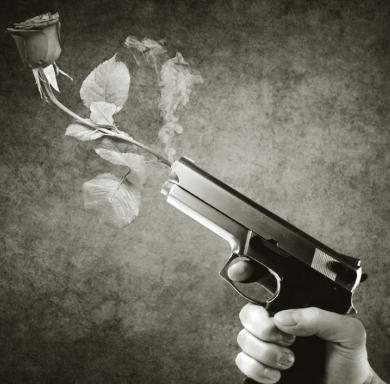瑞士的枪支文化
By Sara Miller Llana

Marksmen fill the recreation hall of this sand-colored shooting club in the wooded hills outside Bern, capping off a weekend competition to commemorate the 1798 Battle of Grauholz in the French Revolutionary Wars.1
There is no shortage of patriotism here—there is even a yodeling club dressed in traditional redtrimmed black felt jackets—and indeed, for many Swiss citizens, guns are as central to their identity as the Alps.2 Switzerland has one of the highest per capita3 rates of guns in the world. “Every Swiss village has a range just like this one,” says Renato Steffen, a top official of the Swiss Shooting Sports Association,4 representing the group at the event. The association counts 2,800 such clubs across the country, with a youth wing5 for children as young as 10.

If this seems like a scene that belongs in gunloving America, there the similarities end.6 The Swisss historic relationship to their arms as members of a standing militia, their motives for keeping them, and the regulations around them diverge from the American experience.7 Its one reason that the prevalence of arms here is not accompanied by a scourge of gun violence.8
Yet Switzerland does provide clues for gun ownership in America. Here divisions also have emerged after gun tragedies and efforts to rein in use—and the story is not settled as a new gun-control directive comes from the European Union.9 But ultimately the two sides have found consensus, getting beyond polarization that paralyzes the American debate even after such tragedies as the school shooting in Parkland, Fla.10 Those who loathe guns here accept their deep-seated position in Swiss tradition as they push for more controls, while gun advocates have pushed back but ultimately accepted more rules and oversight in the past 15 years.11
“Sport and protection of country only”
There is no official count of guns in Switzerland. But according to the Geneva-based Small Arms Survey, Switzerland has more guns circulating per capita than any country besides the US and Yemen.12 The most recent government figures estimate about two million firearms13 in Swiss households. Conscription is mandatory for Swiss males, and citizen soldiers store their weapons at home, making up the bulk of guns in households today.14
The militia, and the culture it has fostered, is seen as part of the common good, binding a nation together in a mission of national security.15 That differs widely from Americas individualistic gun culture. According to a Pew poll16 in 2017, 67 percent of those who own guns in the US cite their personal protection as a major motive.
And differences with the US dont end at cultural ones. In Switzerland, regulations have become much more stringent since the free-wheeling days before a Weapons Act was put into place in 1999.17 And they have steadily tightened over the past 15 years. Military guns, once given to members after their service and passed down for generations, can now only be acquired after service with a firearms acquisition license.18 Since 2007, army-issued ammunition cannot be kept at home.19 A gun under the bed for self-protection? Impossible in Switzerland.
Loaded20 guns, whether military or for sport, cannot be carried on the streets here without a special permit which is rarely issued. Because of conscription, the Swiss are highly trained in weapons handling and storage. As he drives away from the shooting range, Mr. Steffen says he would never want the right to transport his army rifle21 loaded. “No, no,” he says,“that is crazy. For us, guns are for sport, and protection of our country, only.”
Switzerland does grapple with gun death rates higher than European neighbors, the vast majority of it suicide.22 Guns also play a troubling role in domestic disputes. But unlike the US, gun deaths out of self-defense are a rare phenomenon. Criminologist Martin Killias, at the University of St. Gallens law school, built a database looking at homicides committed in self-defense over a 25-year period ending in 2014.23 Of 1,464 homicides, in 23 cases defenders killed victims in self-defense or under duress24. In 15 of those cases, a firearm was used, nine of which were the weapons of on-duty police officers.
The homicide rate in the US is about six times that of the Swiss national average. But when comparing domestic violence that ends in death with a firearm, the ratio is just under two to one, a much smaller gap of gun deaths between American and Swiss households. “It is very illustrative,” Mr. Killias says. “Its not so much that American people are more aggressive, or Swiss are so terribly more peaceful, its simply that gun use in the street in the US is quite common,” he says. “That is why robbery quite often ends with a shooting in America, whereas in Switzerland it is practically never the case.”
Switzerlands gun debates
In 2006, after Swiss alpine skier Corinne Rey-Bellet and her brother were killed by Corinnes estranged husband with his military rifle,25 rules banning the storage of military ammunition at home were created. Today, military members can choose to also keep their weapons at a central arsenal26.
The battle hasnt always favored gun control. In a 2011 referendum27 voters would have, among other things, required military arms to be stored in a central arsenal. Fifty-six percent voted against it. Today, many feel satisfied with where Switzerland is on gun control. “Swiss laws give freedom to the citizen but at the same time they attempt to reduce abuse with guns,” says Luca Filippini, the president of the Swiss Shooting Sports Association.
Switzerlands reform history provides a lesson for the US, argues Erin Zimmerman, an American living in Switzerland who is a former US police officer and gun owner. While the country is vastly different from the US in demographics28 and population, she believes it shows the possibility of consensus for sensible gun regulations.
While some US states have been able to pass gun reform, she says Americans in the national debate are too often only presented with “zero-sum”29 options. They are cast as simply pro- or anti-gun, making middle ground choices more elusive30.“Switzerland has done a really good job of modeling that,” she says.

1. 在伯爾尼郊外树木繁茂的山丘上有家射击俱乐部,沙黄色的游艺厅里挤满了射击能手。他们刚结束了一场周末比赛,以纪念1798年法国大革命战争中的格劳侯尔兹战役。marksman: 射击能手;recreation hall:公众游艺厅,娱乐室;Bern: 伯尔尼,瑞士首都;cap off: 结束;commemorate: 庆祝,纪念;Battle of Grauholz: 格劳侯尔兹战役,1798年3月5日,在法国入侵瑞士的背景下,伯尔尼军队反对法国革命军队的一场战役;French Revolutionary Wars: 法国大革命战争,指1792年到1802年间,新建立的法兰西共和国和反法同盟之间的一系列战争。
2. 这里不乏爱国主义,甚至还有一伙穿着传统红边黑毡夹克的唱约德尔唱腔的人——事实上,对许多瑞士公民来说,枪支就像阿尔卑斯山一样,是他们身份的核心。patriotism: 爱国主义;yodel: 约德尔唱法,瑞士、奥地利山区流行的一种真假嗓音反复变换的唱腔;the Alps: 阿尔卑斯山,欧洲著名山脉,位于欧洲中南部,覆盖了意大利北部边界、法国东南部、瑞士、列支敦士登、奥地利、德国南部及斯洛文尼亚。
3. per capita: 人均。
4. range: 射击场,靶场;Swiss Shooting Sports Association: 瑞士射击运动协会。
5. youth wing: 青年团,青年派系。
6. 如果这个场景看起来像是发生在热爱枪支的美国,那么瑞士和美国也就再没有别的相似之处了。
7. 作为常备国民卫队的成员,瑞士人和枪支武器的历史联系、持有武器的动机,以及相关的法律法规,都和美国的情况迥然不同。standing: 常置的,常备的;militia: // 民兵组织,国民卫队;diverge:(意见、观点等)存在分歧,相悖。
8. prevalence: 流行,盛行;scourge: 祸根,祸害。
9. 在枪击惨案和管控呼声之后,瑞士内部也在枪支管制上产生了分歧;而且欧盟新出台枪支管制的指令之后,矛盾也未能得到解决。rein: 开始对某种情况严加控制;directive: 指示,指令;European Union: 欧洲联盟,简称欧盟,总部设在比利时首都布鲁塞尔,由欧洲共同体发展而来。
10. 但最终双方达成了共识,超越了两极分化——而在美国,即便是在佛罗里达州帕克兰校园枪击事件这样的惨案之后,两极分化依然让美国的枪支辩论陷入瘫痪。polarization: 两极分化;paralyze: 使陷入瘫痪;school shooting in Parkland, Fla: 佛罗里达州帕克兰校园枪击案,发生在2018年2月14日,造成17人死亡,14人受伤。
11. 在瑞士,反對枪支使用的人士一方面推动枪支管控,另一方面也接受了枪支在瑞士传统中根深蒂固的地位;而枪支使用的支持者们尽管奋起斗争,但也在过去的15年中,接受了更多的规定和监管。loathe: 反感,厌恶;oversight: 监督,照管。
12. 然而,根据总部位于日内瓦的小型武器调查(为一独立研究项目),瑞士的人均持枪数量高于其他很多国家,仅次于美国和也门。Small Arms Survey: 小型武器调查,日内瓦高级国际关系学院所进行的一项独立研究,主要围绕小型武器贸易等行为展开调查,旨在为政府、机构和研究人员提供相关数据和信息。
13. firearm: 枪支,枪械。
14. 对于瑞士的男性来说,征兵是义务性的,公民士兵把他们的武器放在家里,这也是如今瑞士家庭中大部分枪支的来源所在。conscription: 征兵;mandatory: 强制的,义务的;bulk: 主体部分。
15. 瑞士的国民自卫队以及它所培育的文化,都被视为公共利益的一部分,正是这些将这个国家团结在一起,共同完成保卫国家安全的使命。
16. Pew poll: 皮尤民调,由皮尤研究中心(Pew Research Center,美国一家独立性民调机构)发起的民意调查,旨在为那些影响美国乃至世界的问题、态度与潮流提供信息和资料。
17. 在瑞士,自1999年武器法案实施以来,随心所欲的日子不复存在,枪支管控变得愈加严格。stringent: 严格的,严厉的;free-wheeling: 自由自在的,随心所欲的。
18. 以前,军人退伍后可以自动获得军用枪支并代代相传,而如今,军人要有枪支获得许可证,才能在退伍后持有枪支。
19. army-issued: 军队发放的;ammunition:弹药,军火。
20. loaded: 上了膛的,枪炮等装有弹药的。
21. rifle: 步枪。
22. 瑞士确实在努力解决枪支致死率高于欧洲邻国的问题,而其中绝大多数案件都是自杀。grapple with: 努力解决某困难问题。
23. 圣加伦大学法学院的犯罪学家马丁·基利亚斯建立了一个数据库,研究了截至2014年的过去25年间,以自卫为目的的杀人案件。criminologist: 犯罪学者,刑事学家;University of St. Gallens: 圣加仑大学,位于瑞士圣加仑地区,是一所以经济、金融、法律和社会学为主的综合性大学;homicide: 谋杀罪,杀人罪。
24. duress: 强迫,胁迫。
25. alpine: 高山滑雪赛的;skier: 滑雪者;estranged: 因夫妻不和而分居的。
26. arsenal: 兵工厂,军械库。
27. referendum: // 公投。
28. demographics: 用于社会分析和市场测算的人口统计数据,如年龄、性别、家庭人数、家庭收入、教育状况等。
29. zero-sum: 零和的,指在赌赛中,胜负双方一方的得益会引起另一方的损失。
30. elusive: 困难的,难以实现的。

